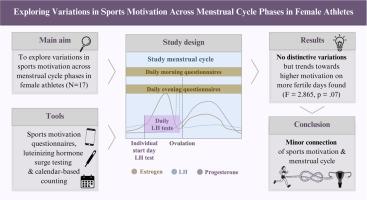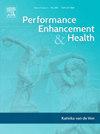Exploring variations in sports motivation across menstrual cycle phases: Insights from a longitudinal within-subjects study with active females
IF 3.7
Q2 HOSPITALITY, LEISURE, SPORT & TOURISM
引用次数: 0
Abstract
Background
Inactivity, as one of the leading risk factors for global mortality, highlights the need for a deeper understanding of how to foster sports motivation. Given the hormonal fluctuations during menstrual cycle phases, it has been suggested that sports motivation may vary as sex hormones impact other areas such as training, emotions, and perception. However, there are inconsistencies in previous studies attributed to varying methodologies in menstrual phase classification and verification. Hence, the main aim of this study was to explore variations in sports motivation across menstrual cycle phases using recommended methods.
Methods
This longitudinal within-subjects study investigated 17 healthy active females (mean age: 28.1 ± 5.3, body mass index: 22.5 ± 2.5 kg/m2) across three menstrual cycles. Using the mPath App, participants completed daily questionnaires that assessed their sports motivation, menstrual cycle day, and sports program. To determine menses and ovulation during the participant’s menstrual cycle, calendar-based counting and luteinizing hormone testing were employed.
Results
Motivation scores were highest during mid-follicular days and periovulatory days, although the overall differences between the menstrual cycle phases were insignificant. Positive correlations were found between periovulatory sports motivation and sport session frequency, and negative between periovulatory sport session intensity and frequency.
Conclusion
This study offers new insights for sports motivation and menstrual cycle research, suggesting that there are no significant differences in sports motivation across the hormonal events of the menstrual cycle. Additional factors like coaching, social support, and enjoyment of exercise may also exert influence and therefore warrant further investigation through mixed-method strategies to investigate these psychosocial factors alongside to the menstrual cycle. Future research should replicate these findings using more precise measurements of progesterone and estrogen to enhance methodological accuracy and reliability.

探索月经周期阶段运动动机的变化:来自活跃女性纵向研究的见解
运动作为全球死亡的主要危险因素之一,突出了对如何培养运动动机有更深入了解的必要性。考虑到月经周期阶段的荷尔蒙波动,有人认为,运动动机可能会随着性激素对训练、情绪和感知等其他方面的影响而变化。然而,由于经期分类和验证的方法不同,以往的研究存在不一致性。因此,本研究的主要目的是使用推荐的方法探索月经周期阶段运动动机的变化。方法对17名平均年龄28.1±5.3岁,体重指数22.5±2.5 kg/m2的健康运动女性进行3个月经周期的纵向研究。使用mPath应用程序,参与者每天完成问卷调查,评估他们的运动动机、月经周期和运动计划。为了确定月经和排卵在参与者的月经周期,基于日历计数和黄体生成素测试被采用。结果动机得分在卵泡中期和排卵期最高,但月经周期各阶段的总体差异不显著。排卵期运动动机与运动次数呈正相关,运动强度与运动次数呈负相关。结论本研究为运动动机与月经周期的研究提供了新的见解,表明运动动机在月经周期的激素事件中没有显著差异。其他因素,如教练、社会支持和运动的乐趣也可能产生影响,因此需要通过混合方法策略进一步调查这些心理社会因素以及月经周期。未来的研究应该使用更精确的黄体酮和雌激素测量来重复这些发现,以提高方法的准确性和可靠性。
本文章由计算机程序翻译,如有差异,请以英文原文为准。
求助全文
约1分钟内获得全文
求助全文
来源期刊

Performance enhancement and health
Social Sciences-Health (social science)
CiteScore
4.70
自引率
0.00%
发文量
27
审稿时长
57 days
 求助内容:
求助内容: 应助结果提醒方式:
应助结果提醒方式:


